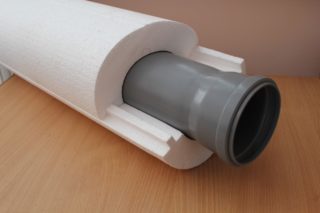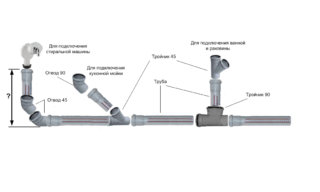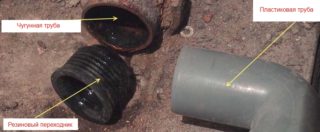According to SNIPs, cast iron sewer lines are changed once every forty years. However, if blockages, leaks often occur, an unpleasant odor leaks out all the time, the system must be replaced earlier. Following the technology, you can do it yourself, without hiring professionals.
Selection of material for a new pipeline
Steel tubular products are cheaper, more durable and more resistant to high temperatures. But at the same time, they quickly rust, which is why they are rarely used for installation in apartments.
Cast iron pipes are more expensive than steel pipes, but they are also more resistant to rust. They are suitable for laying communication networks in apartments. The disadvantages are a decrease in throughput over time, difficulties in installation due to the large mass of the product and the mandatory availability of the necessary special equipment for installation. The advantages of cast iron are high strength and long service life.
The most common option is considered to be a polymer pipeline. Pipe and fitting elements are produced in two types: from polypropylene or polyvinyl chloride.
Advantages of polymer lines
Plastic pipes have many advantages:
- small weight, thanks to which they are easy to mount;
- lack of special equipment during installation;
- rust resistance.
The smooth surface of the plastic prevents plugs from forming and does not overgrow over time. In addition, polymer products look aesthetically pleasing, and their cost is much lower than parts made of other materials.
Disadvantages of plastic pipes and their elimination

Polymer products have one significant drawback - noise. For sound insulation, the following methods are used:
- The pipes are insulated from the walls with the help of damper clamps, and from the ceilings - with polyurethane foam plates.
- To eliminate the unpleasant bubbling of water in the pipeline, polyurethane foam or foam insulators are used. Wrap up the riser and the main line.
- Foamed polyethylene helps to remove the sound wave. But this material does not last long and can begin to sour and even stick if it is hot in the room.
The best option would be to purchase special pipes with a sound-absorbing effect. They are made of plastic with the addition of mineral powder. A similar material for sound insulation is not inferior to cast iron products. The disadvantages of such pipes are their high cost and short service life (no more than twenty years).
Replacement of pipes at the expense of the management company
By law, the obligation to repair and replace part of the communications in the apartment is assigned to the housing company and is carried out at its expense. The very process of performing work on the repair and replacement of the sewage system is regulated by:
- Rules for the maintenance of common property in apartment buildings.
- Norms and rules for the operation of the housing stock.
- Methodical recommendations for the maintenance and repair of the housing stock.
Risers operated by several apartments of the same entrance belong to joint ownership and housing and communal services should be engaged in their replacement. Taps from the riser to the first connection point are also considered common property. Maintenance and repair of all other pipelines in the apartment is at the expense of the owners.
Tools and materials
If you decide to change the piping yourself, a tool kit is needed. It includes:
- grinder or pipe cutter (used for cutting pipes, dismantling a cast iron riser);
- a hammer;
- bubble level;
- chisel;
- roulette;
- plumb line.
Additionally, you may need protective goggles and a respirator to prevent the ingress of metal splinters and dust.
Preparatory work
When drawing up a diagram, it is necessary to take into account all sanitary devices, their locations (kitchen, bathroom, toilet) and how they will be connected to the outlets of the highway.
When replacing an external sewer system in a private house, you need to find a scheme for laying the old pipeline in the ground in order to know where to open the soil. If the damaged area is located under the asphalt, so as not to spoil the surface, a trenchless method of laying a new highway is used.
Residents of high-rise buildings on the upper floors only need to coordinate work with the management company and the housing department. Those who live on the lower floors need to warn neighbors not to use plumbing fixtures for some time.
The last stage of preparation is to turn off the water supply pipes and free the workplace from foreign objects.
Installation steps
- The pipe of the required length is cut with a pipe cutter or grinder, then chamfers are removed and cleaned with sandpaper. Install an adapter from cast iron to plastic into the pipe section.
- The resulting structure is pushed onto the rest of the pipe protruding from the ceiling until it stops. If work is carried out on the top floor, a plug is installed. The permissible gap between the elements should not exceed 5 millimeters.
- Fasteners for the riser are installed on the wall. If the ceilings are at a height of more than 3 meters, four clamps are installed. For familiar ceilings with a height of 2.5 meters, three fasteners are enough.
- Before final installation, sleeves and gaskets are inserted into pipes and fittings. The joints are coated with soap to facilitate assembly. After all parts are assembled, the riser is fixed to the fasteners.
Upon completion of installation, a test check of the pipeline is performed. For this, a large amount of water is poured into the sewer line. If there are no leaks, the new system can be used.
Sewer pipes made of plastic can also be connected using the socket method. With this method, the end of the pipe is inserted into the expanded part (socket) of the other. The tightness of the joint is ensured by a ring-shaped rubber gasket.
Possible mistakes
If the old riser is not leaking, it is still better to replace it. Moreover, you can convince employees of the management company of the need for this action and entrust the work to them. Otherwise, due to the pressure difference at the transition between cast iron and plastic, there is a risk of breakage.
When installing the sewage system, it is worth considering the following points:
- It is recommended to remove the old cast iron tee, which was used to connect the toilet and the smaller sewer pipe, or a straight outlet, and replace it with a plastic product. Modern elements take up less space and save the volume of the bathroom.
- You should not be afraid to pack the wiring of water and sewer pipes under the tiles. The anti-corrosion structure of plastic pipes and high-quality rubber seals at the joints eliminate the risk of breakage.
- It is important to fix the line in an open area with a length of more than a meter with special fasteners. The pipes can become clogged and need to be cleaned. Loose connections will simply disperse.
Another mistake is saving on materials and work. If you have never held a tool in your hands, replacing the sewer system yourself will be difficult and troublesome. It's easier to call professionals.
Prices for work on replacing sewer pipes in a house or apartment start at 200 rubles per running meter. The experience and qualifications of the master, the cost of materials, the complexity of the work matter. Using someone else's work, you will save time and, in the event of a breakthrough, you will be able to bring the craftsmen to justice.












